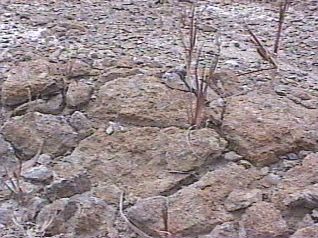|
|
|
|
|
Description of Site FFXA, Florence, Kentucky
The Mollusk/Echinoderm Micromorph Assemblage This particular micromorph assemblage layer is located somewhere in the middle of the Arnheim Formation. There are several known micromorph layers in the Arnheim. They have been called as "fossil hash with Cyclora gastropods" in some publications (Cincinnati Fossils, Davis, 1998). The layer I have found on one site in Florence, Kentucky is unique in color and composition from the others that are documented. This 1 foot layer consists of sandstones and loose sand material. The sandstone is comprised of a reddish brown gritty matrix filled with tiny gastropods, pelecypods, bryozoans, annelid work tubes, cyclocystoid plates and other unidentified plates and steinkerns which all appear as white dots in the matrix when first coming across such rock. The gastropods and bryozoans are white to yellow in color. The gastropods appear to have a coating of brownish/blackish material, perhaps contributing to their yellowish coloring. The mystery plates, similarly, vary in color from white to yellow and possess a brownish black grit coating. The quantity of Cyclcocystoid plates in this "fossil hash" is astounding. They are very abundant and ubiquitous throughout this layer. There is a "mystery fossil" that is also ubiquitous in this layer but only slightly abundant. One specimen of the "mystery fossil" can be found on the surface of almost every rock in the layer. Other types material found in this sand and matrix include a conodont and a scolecodont. Other mystery plates found include a round or slightly pyramidal ball with a protruding stick shape and a shield-shaped disc plate. These are somewhat less abundant than the mystery ridged plate herein described. Removal of samples of the loose sand surrounding the "fossil hash" rocks has yielded many specimens of the mystery fossil free from matrix. Almost half of the specimens found are double-plate specimens. A couple of three-plate specimens have been found loose, but many more three-plate examples have been found imbedded in the surface of the rocks. One four-or-five-plate specimen has also been found on the surface of a rock. The layer containing this fossil hash is just above a one-foot-thick limestone hard layer consisting almost entirely of Rafinesquina Brachiopod fragments. Similar layers of badly fragmented Rafinesquina can be found above the "fossil hash" layer. These layers are not as thick as the one immediately below the layer in question. Other layers above the "fossil hash" layer include shale with zones of very abundant Zygospira Brachiopods. There are other gastropod zones consisting of larger specimens including Cyclonema. Fragments of the trilobites Isotelus and Flexicalymene have been found in these shale layers as well as one complete Flexicalymene. One such shale layer of abundant Zygospira Brachiopods exists immediately above the "fossil hash" layer.
Click here for a discussion (and pictures) of
the Echinoderm preservation in this layer. |

